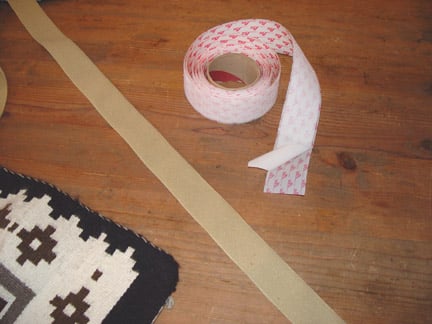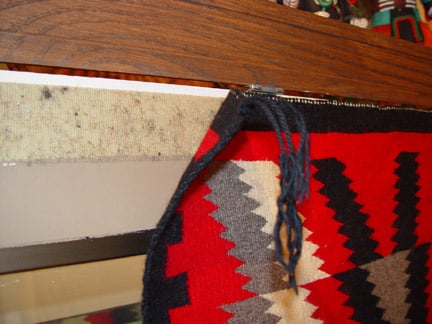How to Display Navajo Rugs
Most Navajo blankets and rugs may be displayed in a variety of ways but consideration of the type of weave, age, condition are important factors.
On the floor
On the floor, weavings are often displayed on natural wool or other non-synthetic rug pads and can help keep rugs from slipping on hard surfaces and add to the life and durability of the rug. (Synthetic pads and pads that might get gummy or melt in hot conditions or pads that may transfer color or pattern to rug should be avoided!)
On the wall -- Push-pins
5/8" Aluminum Head Push pins are a popular choice if displaying directly on standard drywall. The heads may be painted with nail polish selected to match the color of the rug's border and should work for all but the heaviest of rugs. Generally place one pin every 4 to 8" across the top of the rug depending on the rug's weight, be sure there is no drooping between pins , and place one in each bottom corner. Its a good idea to flip rugs front to back at least once a year and if not pictorial you can also flip top and bottom. For a more professional display check the Velcro method shown below.

On the wall --Tape-backed Velcro Method(click photos to enlarge)
Tape-backed Velcro (usually available through your local hardware store or home improvement store) can be attached to a narrow strip of wood which then can be wood-screwed into a wall to display Navajo blankets and Navajo rugs. Only the male "hook side" (white Velcro in photo) need be used; the female "texture" side is not needed for display as most Navajo rugs and blankets of homespun Navajo sheep wool yarn will have sufficient nap that can be directly rubbed into the Velcro loops to hold the rug in place. Exceptions to this display method are rugs that are too large or heavy or those that have little or no nap (such as Germantown trade yarn weavings ot tapestry weaves). Most other small to medium sized rugs up to about 4'x6' or so can easily be displayed with this method.

Even with only half of the top edge of this Navajo rug rubbed into the Velcro, the entire weight is already being supported. A small piece of Velcro can also be used in each lower corner if desired to hold the rug tightly against the wall. Be sure to attach the tape-backed piece of Velcro against a separate piece of wood before mounting on the wall as the tape on the back of the Velcro if attached directly to the wall will remove paint (and probably some wallboard ) if applied directly to wall without using a separate wood strip.

Press the edge of the rug firmly into the Velcro rubbing the nap of the wool yarn into the hooks/loops of the Velcro

The advantages of using Velcro include that the display technique is hidden / covered by the rug itself and that the rug may be easily removed for vacuuming or turning (its a good idea to rotate Navajo rugs and blankets "back to front"/"front to back" periodically so both sides get even exposure to any ambient UV light as well as to check for hiding moths or spiders that might damage the wool.
Typical Navajo Weaving Display Techniques by Type
Navajo Regional Rugs and "Pan Reservation" Rugs c 1900-Today: The majority of Navajo rugs woven of homespun Navajo sheep wool yarn and made after 1890 of medium or heavier weave can be used on either floor or wall interchangeably. On the floor they are generally displayed with a floor pad. On the wall they are generally displayed on Velcro, although there are additional options to wall display as noted above.
Runners, samplers ,squares and small weavings : Typically are either wall displayed but are popularly used on table tops and sofa tables, especially for display under a Pueblo Indian pot or an antique American Indian basket
Navajo Chief's Blankets: Typically displayed on the wall horizontally as they would have been worn (with the interior warp running vertically); occasionally displayed on mannequin torsos. Pre-1900 chiefs blankets are never displayed on the floor, although some post-1900 rug weight chiefs pattern rugs can be used on the floor if desired.
Navajo Serapes/ Shoulder blankets: Typically displayed vertically (with the interior warp running vertically); if displayed on mannequin torso they are draped horizontally as they would have been worn. Soft Transitional blankets are also popular choices for use as decorative bed covers in Southwest and Draftsmen style homes, as well as sofa, chair and furniture throws and covers. Blankets drape nicely over railings to add color to any room.
Navajo pictorial rugs: Typically pictorials are wall displayed although some heavier room-sized floor rugs are sometimes available for floor use.
Navajo Germantown Blankets: Typically wall displayed vertically unless in Chiefs blanket form. Cannot be used on floor.
Navajo Tapestry weaves: Typically wall displayed or on tabletops.
Large rugs over 5'x8' are generally of rug weight and used on the floor.


